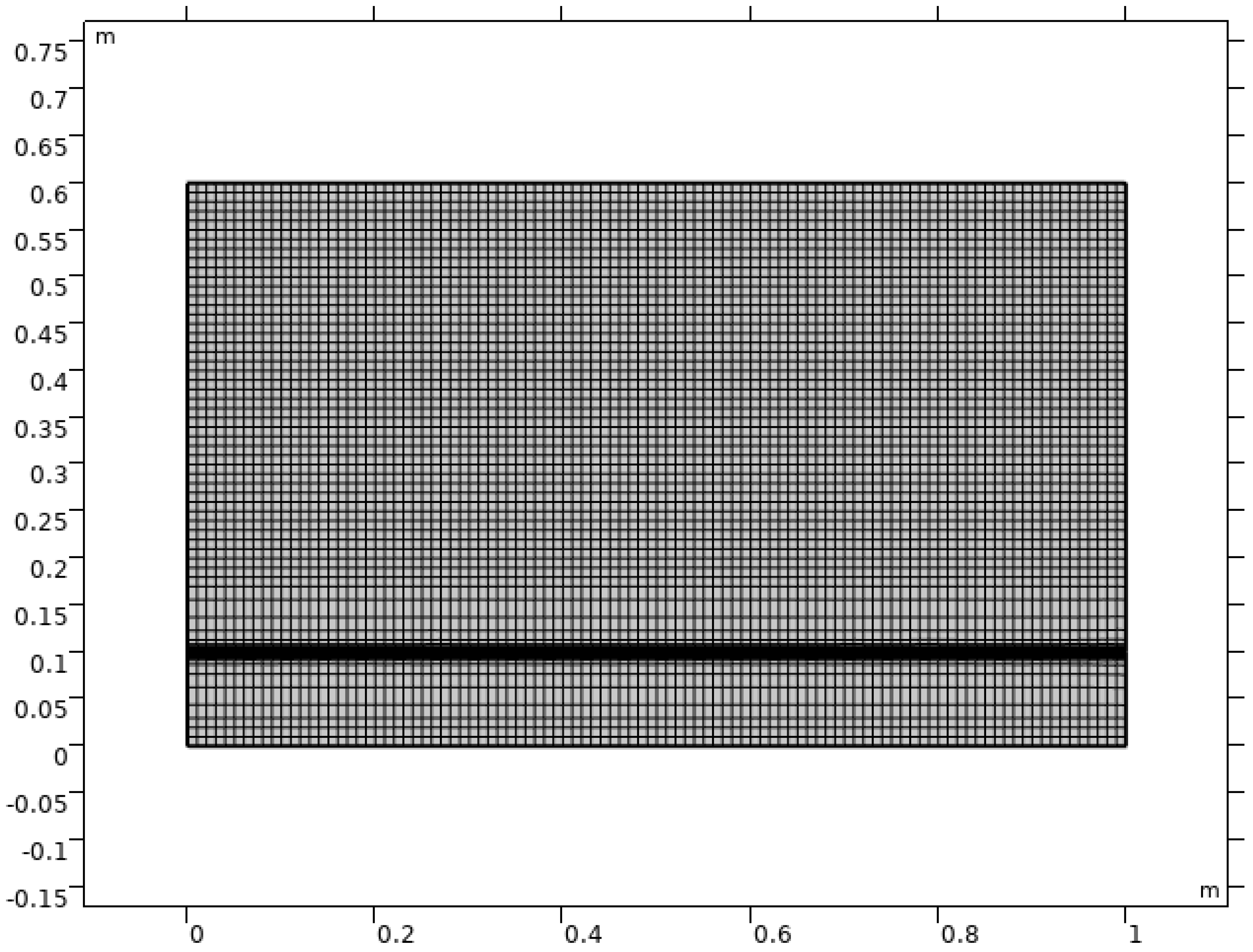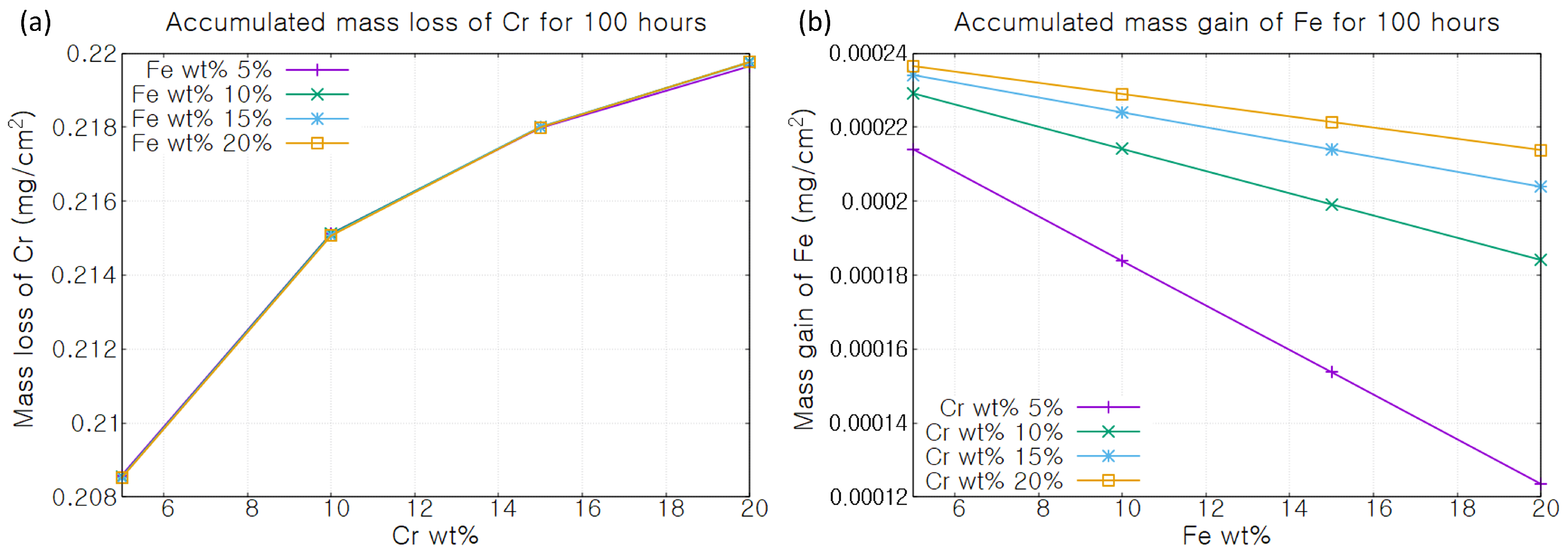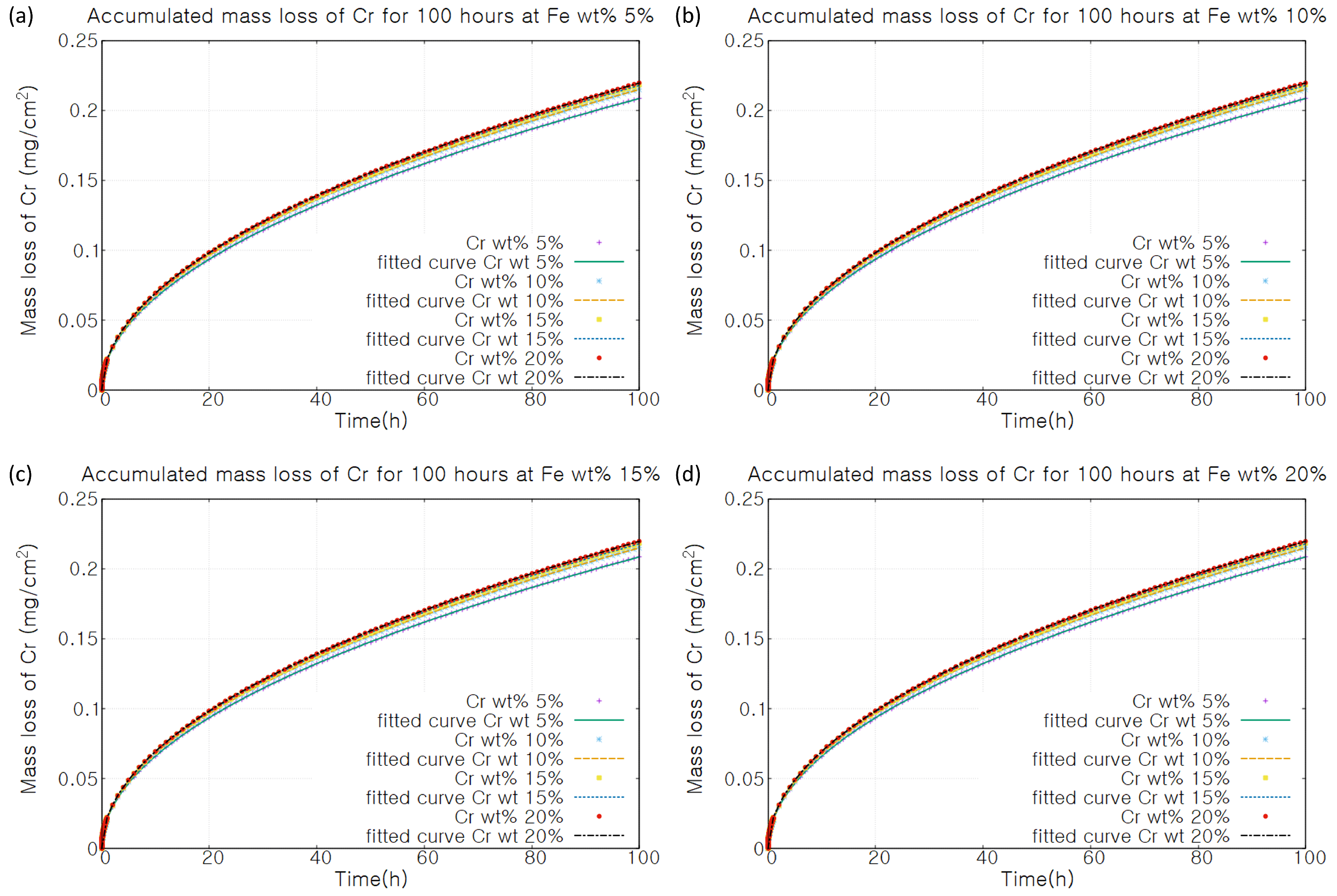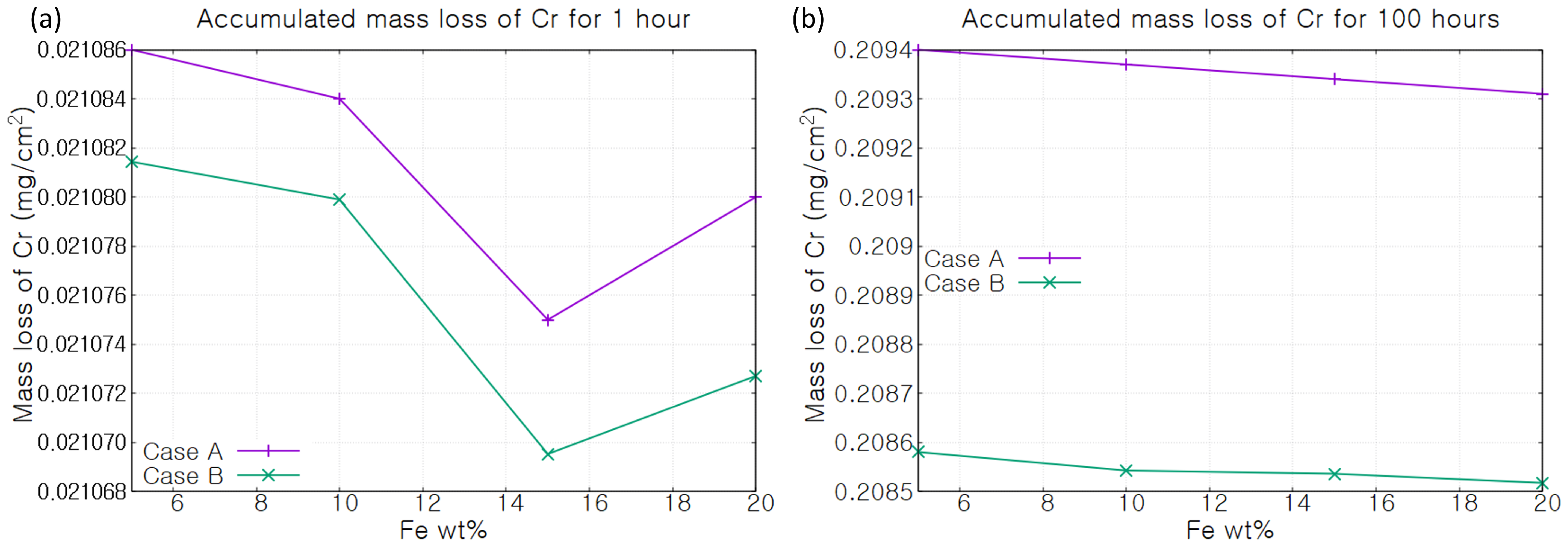Surface Reaction-Diffusion-Coupled Simulation of Ni–Fe–Cr Alloy under FLiNaK Molten Salt
Abstract
:1. Introduction
2. Model Description
2.1. Model Geometry
2.2. Simulation Strategy
2.3. Model Parameters and Initial Conditions
3. Results
4. Discussion
- Case A: Cr concentration is fixed within the material.
- Case B: Cr depletion takes place due to corrosion and Cr atoms diffuse within the material.
5. Conclusions and Future Works
Author Contributions
Funding
Data Availability Statement
Conflicts of Interest
Correction Statement
References
- Lane, J.A.; MacPherson, H.G.; Maslan, F. Fluid Fuel Reactors: Molten Salt Reactors, Aqueous Homogeneous Reactors, Fluoride Reactors, Chloride Reactors, Liquid Metal Reactors and Why Liquid Fission; Addison-Wesley Publishing Co., Ltd.: London, UK, 1958. [Google Scholar]
- Beneš, O.; Souček, P. 6—Molten salt reactor fuels. In Advances in Nuclear Fuel Chemistry; Piro, M.H., Ed.; Woodhead Publishing Series in Energy; Woodhead Publishing: Sawston, UK, 2020; pp. 249–271. [Google Scholar] [CrossRef]
- Serp, J.; Allibert, M.; Beneš, O.; Delpech, S.; Feynberg, O.; Ghetta, V.; Heuer, D.; Holcomb, D.; Ignatiev, V.; Kloosterman, J.L.; et al. The molten salt reactor (MSR) in generation IV: Overview and perspectives. Prog. Nucl. Energy 2014, 77, 308–319. [Google Scholar] [CrossRef]
- Fredrickson, G.L.; Cao, G.; Gakhar, R.; Yoo, T.S. Molten Salt Reactor Salt Processing—Technology Status; Idaho National Laboratory (INL): Idaho Falls, ID, USA, 2018. [CrossRef]
- Robertson, R.C. MSRE Design & Operations Report Part 1 Description of Reactor Design; Oak Ridge National Laboratory (ORNL): Oak Ridge, TN, USA, 1965. [CrossRef]
- Rosenthal, M.; Kasten, P.; Briggs, R. Molten-salt reactors—History, status, and potential. Nucl. Appl. Technol. 1970, 8, 107–117. [Google Scholar] [CrossRef]
- Ho, M.; Yeoh, G.; Braoudakis, G. Molten Salt Reactors, Materials and Processes for Energy: Communicating Current Research and Technological Developments; Formatex Research Center: Norristown, PA, USA, 2013; pp. 761–768. [Google Scholar]
- Lantelme, F.; Groult, H. Molten Salts Chemistry: From Lab to Applications; Newnes: Oxford, UK, 2013. [Google Scholar]
- Kamei, T.; Hakami, S. Evaluation of implementation of thorium fuel cycle with LWR and MSR. Prog. Nucl. Energy 2011, 53, 820–824. [Google Scholar] [CrossRef]
- Elsheikh, B.M. Safety assessment of molten salt reactors in comparison with light water reactors. J. Radiat. Res. Appl. Sci. 2013, 6, 63–70. [Google Scholar] [CrossRef]
- Guo, S.; Zhang, J.; Wu, W.; Zhou, W. Corrosion in the molten fluoride and chloride salts and materials development for nuclear applications. Prog. Mater. Sci. 2018, 97, 448–487. [Google Scholar] [CrossRef]
- Ignatiev, V.; Surenkov, A. 5-Corrosion phenomena induced by molten salts in Generation IV nuclear reactors. In Structural Materials for Generation IV Nuclear Reactors; Yvon, P., Ed.; Woodhead Publishing: Sawston, UK, 2017; pp. 153–189. [Google Scholar] [CrossRef]
- Yoshioka, R.; Kinoshita, M.; Scott, I. 7—Materials. In Molten Salt Reactors and Thorium Energy; Dolan, T.J., Ed.; Woodhead Publishing: Sawston, UK, 2017; pp. 189–207. [Google Scholar] [CrossRef]
- Niketan, S.; Patel, V.P.; Boča, M. High-Temperature Corrosion Behavior of Superalloys in Molten Salts—A Review. Crit. Rev. Solid State Mater. Sci. 2017, 42, 83–97. [Google Scholar] [CrossRef]
- Zhang, J.; Forsberg, C.W.; Simpson, M.F.; Guo, S.; Lam, S.T.; Scarlat, R.O.; Carotti, F.; Chan, K.J.; Singh, P.M.; Doniger, W.; et al. Redox potential control in molten salt systems for corrosion mitigation. Corros. Sci. 2018, 144, 44–53. [Google Scholar] [CrossRef]
- Khanna, A.S. Introduction to High Temperature Oxidation and Corrosion; ASM International: Almere, The Netherlands, 2002. [Google Scholar]
- MacPherson, H. Development of materials and systems for the molten-salt reactor concept. React. Technol. 1972, 15, 136–155. [Google Scholar]
- Abu-warda, N.; García-Rodríguez, S.; Torres, B.; Utrilla, M.V.; Rams, J. Effect of Molten Salts Composition on the Corrosion Behavior of Additively Manufactured 316L Stainless Steel for Concentrating Solar Power. Metals 2024, 14, 639. [Google Scholar] [CrossRef]
- Kanjanaprayut, N.; Siripongsakul, T.; Promdirek, P. Intergranular Corrosion Analysis of Austenitic Stainless Steels in Molten Nitrate Salt Using Electrochemical Characterization. Metals 2024, 14, 106. [Google Scholar] [CrossRef]
- Fernández, A.; Galleguillos, H.; Fuentealba, E.; Pérez, F. Corrosion of stainless steels and low-Cr steel in molten Ca(NO3)2–NaNO3–KNO3 eutectic salt for direct energy storage in CSP plants. Sol. Energy Mater. Sol. Cells 2015, 141, 7–13. [Google Scholar] [CrossRef]
- Soleimani Dorcheh, A.; Durham, R.N.; Galetz, M.C. Corrosion behavior of stainless and low-chromium steels and IN625 in molten nitrate salts at 600 °C. Sol. Energy Mater. Sol. Cells 2016, 144, 109–116. [Google Scholar] [CrossRef]
- Sun, H.; Wang, J.; Li, Z.; Zhang, P.; Su, X. Corrosion behavior of 316SS and Ni-based alloys in a ternary NaCl-KCl-MgCl2 molten salt. Sol. Energy 2018, 171, 320–329. [Google Scholar] [CrossRef]
- Wang, J.-W.; Zhang, C.-Z.; Li, Z.-H.; Zhou, H.-X.; He, J.-X.; Yu, J.-C. Corrosion behavior of nickel-based superalloys in thermal storage medium of molten eutectic NaCl-MgCl2 in atmosphere. Sol. Energy Mater. Sol. Cells 2017, 164, 146–155. [Google Scholar] [CrossRef]
- Muránsky, O.; Yang, C.; Zhu, H.; Karatchevtseva, I.; Sláma, P.; Nový, Z.; Edwards, L. Molten salt corrosion of Ni-Mo-Cr candidate structural materials for Molten Salt Reactor (MSR) systems. Corros. Sci. 2019, 159, 108087. [Google Scholar] [CrossRef]
- Delpech, S.; Carrière, C.; Chmakoff, A.; Martinelli, L.; Rodrigues, D.; Cannes, C. Corrosion Mitigation in Molten Salt Environments. Materials 2024, 17, 581. [Google Scholar] [CrossRef]
- Mcmurray, J.W.; Besmann, T.M.; Ard, J.; FItzpatrick, B.; Piro, M.; Jerden, J.; Williamson, M.; Collins, B.S.; Betzler, B.R.; Qualls, A.L. Multi-Physics Simulations for Molten Salt Reactor Evaluation: Chemistry Modeling and Database Development; Oak Ridge National Laboratory (ORNL): Oak Ridge, TN, USA, 2018. [CrossRef]
- MaeHyun, C.; Hyeong-Jun, J.; Jungshin, K.; Kunok, C. Development of Numerical Analysis Model for New Magnesium Electrolysis Process Using COMSOL. Korean J. Met. Mater. 2023, 61, 625–631. [Google Scholar] [CrossRef]
- Wang, W.; Guan, B.; Wei, X.; Lu, J.; Ding, J. Cellular automata simulation on the corrosion behavior of Ni-base alloy in chloride molten salt. Sol. Energy Mater. Sol. Cells 2019, 203, 110170. [Google Scholar] [CrossRef]
- Li, X.; Xu, T.; Liu, M.; Song, Y.; Zuo, Y.; Tang, Z.; Yan, L.; Wang, J. Thermodynamic and kinetic corrosion behavior of alloys in molten MgCl2–NaCl eutectic: FPMD simulations and electrochemical technologies. Sol. Energy Mater. Sol. Cells 2022, 238, 111624. [Google Scholar] [CrossRef]
- Vivek Bhave, C.; Zheng, G.; Sridharan, K.; Schwen, D.; Tonks, M.R. An electrochemical mesoscale tool for modeling the corrosion of structural alloys by molten salt. J. Nucl. Mater. 2023, 574, 154147. [Google Scholar] [CrossRef]
- Feng, J.; Gao, J.; Mao, L.; Bedell, R.; Liu, E. Modeling the Impact of Grain Size on Corrosion Behavior of Ni-Based Alloys in Molten Chloride Salt via Cellular Automata. Metals 2024, 14, 931. [Google Scholar] [CrossRef]
- Kane, R.D. Molten Salt Corrosion. In Corrosion: Fundamentals, Testing, and Protection; ASM International: Almere, The Netherlands, 2003. [Google Scholar] [CrossRef]
- Was, G.; Kruger, R. A thermodynamic and kinetic basis for understanding chromium depletion in Ni-Cr-Fe alloys. Acta Metall. 1985, 33, 841–854. [Google Scholar] [CrossRef]
- Einstein, A. Über die von der molekularkinetischen Theorie der Wärme geforderte Bewegung von in ruhenden Flüssigkeiten suspendierten Teilchen. Ann. Phys. 1905, 4, 549–560. [Google Scholar] [CrossRef]
- Zuo, Y.; Song, Y.L.; Tang, R.; Qian, Y. A novel purification method for fluoride or chloride molten salts based on the redox of hydrogen on a nickel electrode. RSC Adv. 2021, 11, 35069–35076. [Google Scholar] [CrossRef] [PubMed]
- Wu, W.; Guo, S.; Zhang, J. Exchange Current Densities and Charge-Transfer Coefficients of Chromium and Iron Dissolution in Molten LiF-NaF-KF Eutectic. J. Electrochem. Soc. 2017, 164, C840. [Google Scholar] [CrossRef]
- Zheng, G. Corrosion Behavior of Alloys in Molten Fluoride Salts. Ph.D. Thesis, University of Wisconsin, Madison, WI, USA, 2015. [Google Scholar]
- Raiman, S.S.; Lee, S. Aggregation and data analysis of corrosion studies in molten chloride and fluoride salts. J. Nucl. Mater. 2018, 511, 523–535. [Google Scholar] [CrossRef]
- Olson, L.C.; Ambrosek, J.W.; Sridharan, K.; Anderson, M.H.; Allen, T.R. Materials corrosion in molten LiF–NaF–KF salt. J. Fluor. Chem. 2009, 130, 67–73. [Google Scholar] [CrossRef]








| Alloy | Molten Salt | Microstructure | Surface Reaction | |
|---|---|---|---|---|
| Wang et al. [28] | 625 | NaCl–MgCl2–CaCl2 | N/A | Stochastic approach |
| Li et al. [29] | Ni-Cr-Fe-Mn-Co | NaCl–MgCl2 | N/A | Berzins-Delahay |
| Bhave et al. [30] | Ni-Cr | FLiBe | Grain Boundary | Simplified Butler-Volmer |
| Feng et al. [31] | 625 | Chloride | Grain Boundary | Stochastic approach |
| Current work | Ni-Cr-Fe | FLiNaK | N/A | Butler-Volmer |
| Oxidation Reaction | Reduction Reaction |
|---|---|
| Species j | (mol/m3) | (mol/m3) | (Å) |
|---|---|---|---|
| 59,674.26 | 1000 | 1.33 | |
| 38,342.39 | 38,342.39 | 0.76 | |
| 5861.198 | 5861.198 | 1.02 | |
| 15,470.68 | 15,470.68 | 1.38 | |
| 0.87 | |||
| 0.755 | |||
| 0.75 | |||
| 0.69 | |||
| 0.70 | |||
| HF(g) | 5.9674 | 11.91 | 1.55 |
| 11.91 | 0.1 | ||
| 138,461.5385 | 138,461.5385 | - |
| Reaction | Species j | (V) | (mA/cm2) | |
|---|---|---|---|---|
| −3.9 | 0.88 | 0.22 | ||
| −3.55 | 0.88 | 0.22 | ||
| −3.5 | 6.15 | 0.11 | ||
| −3.1 | 6.15 | 0.11 | ||
| −3.05 | 0.88 | 0.22 | ||
| −5.45 | 0.05 | 0.5 | ||
| −5.1 | 0.05 | 0.5 | ||
| −4.9 | 0.05 | 0.5 | ||
| HF(g) | −2.89 | 6.15 | 0.5 |
| (mA/cm2) | Mass Loss of Cr (mg/cm2) | (mA/cm2) | Mass Loss of Cr (mg/cm2) | ||
|---|---|---|---|---|---|
| 0.44 | 0.11 | 0.20856 | 3.075 | 0.25 | 0.20857 |
| 0.88 | 0.22 | 0.20858 | 6.15 | 0.5 | 0.20858 |
| 1.32 | 0.33 | 0.20856 | 9.225 | 0.75 | 0.20857 |
| Cr/Fe wt% | a | b | c | d | e | f |
|---|---|---|---|---|---|---|
| 5%/5% | −0.305326 | 0.225155 | 0.291936 | 0.217424 | 0.0343678 | 0.451575 |
| 5%/10% | −0.305521 | 0.227901 | 0.291763 | 0.220085 | 0.0347356 | 0.450973 |
| 5%/15% | −0.305128 | 0.225001 | 0.292124 | 0.217476 | 0.0339732 | 0.452563 |
| 5%/20% | −0.305243 | 0.225154 | 0.292016 | 0.217501 | 0.0341976 | 0.452018 |
| 10%/5% | −0.304331 | 0.215228 | 0.293086 | 0.208162 | 0.0328337 | 0.457936 |
| 10%/10% | −0.30419 | 0.215345 | 0.293223 | 0.208408 | 0.0325575 | 0.458842 |
| 10%/15% | −0.305004 | 0.221413 | 0.292455 | 0.213831 | 0.0341366 | 0.454917 |
| 10%/20% | −0.305047 | 0.222266 | 0.292413 | 0.214658 | 0.0342247 | 0.454917 |
| 15%/5% | −0.304488 | 0.214879 | 0.292953 | 0.207615 | 0.0334026 | 0.457576 |
| 15%/10% | −0.304517 | 0.215966 | 0.292929 | 0.208682 | 0.0334617 | 0.457616 |
| 15%/15% | −0.304812 | 0.217429 | 0.292649 | 0.209875 | 0.0340312 | 0.456204 |
| 15%/20% | −0.304681 | 0.217078 | 0.292775 | 0.209652 | 0.0337759 | 0.456869 |
| 20%/5% | −0.302105 | 0.190926 | 0.295258 | 0.185882 | 0.0288744 | 0.470715 |
| 20%/10% | −0.304236 | 0.212926 | 0.293203 | 0.205823 | 0.0330726 | 0.45927 |
| 20%/15% | −0.303769 | 0.209021 | 0.293649 | 0.202366 | 0.0321552 | 0.451467 |
| 20%/20% | −0.304003 | 0.211595 | 0.293427 | 0.204724 | 0.0326191 | 0.460399 |
Disclaimer/Publisher’s Note: The statements, opinions and data contained in all publications are solely those of the individual author(s) and contributor(s) and not of MDPI and/or the editor(s). MDPI and/or the editor(s) disclaim responsibility for any injury to people or property resulting from any ideas, methods, instructions or products referred to in the content. |
© 2024 by the authors. Licensee MDPI, Basel, Switzerland. This article is an open access article distributed under the terms and conditions of the Creative Commons Attribution (CC BY) license (https://creativecommons.org/licenses/by/4.0/).
Share and Cite
Cho, M.; Tonks, M.R.; Chang, K. Surface Reaction-Diffusion-Coupled Simulation of Ni–Fe–Cr Alloy under FLiNaK Molten Salt. Metals 2024, 14, 1088. https://doi.org/10.3390/met14091088
Cho M, Tonks MR, Chang K. Surface Reaction-Diffusion-Coupled Simulation of Ni–Fe–Cr Alloy under FLiNaK Molten Salt. Metals. 2024; 14(9):1088. https://doi.org/10.3390/met14091088
Chicago/Turabian StyleCho, Maehyun, Michael R. Tonks, and Kunok Chang. 2024. "Surface Reaction-Diffusion-Coupled Simulation of Ni–Fe–Cr Alloy under FLiNaK Molten Salt" Metals 14, no. 9: 1088. https://doi.org/10.3390/met14091088
APA StyleCho, M., Tonks, M. R., & Chang, K. (2024). Surface Reaction-Diffusion-Coupled Simulation of Ni–Fe–Cr Alloy under FLiNaK Molten Salt. Metals, 14(9), 1088. https://doi.org/10.3390/met14091088






